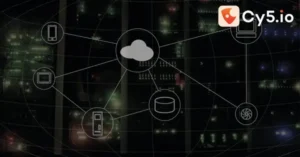Graph-driven threat hunting in CSPM uses a cloud asset/identity relationship graph to visualize attack paths, expose toxic IAM chains, map lateral movement, and estimate blast radius. Teams pivot by entity (principal, resource, network hop) and apply risk-based prioritization to fix the few misconfigurations that collapse many paths—across AWS, Azure, and GCP. Platforms like Cy5 (Ion Cloud Platform) operationalize this with graph-native analytics and least-privilege workflows.
Executive TL;DR.
Lists tell you what is wrong; graphs show how attackers get to data—and which single fix blocks many routes. By unifying IAM, network reachability, data sensitivity, and Kubernetes context into a cloud security graph, your team can simulate/detect cloud attack paths, cut blast radius, and drive risk-based remediation. Cy5 / Ion Cloud Platform automates this pipeline: ingest → graph → attack paths → explainable risk scores → IaC-safe remediation PRs.
Key Takeaways
- Graph-driven threat hunting converts posture noise into fixable attack paths.
- Graph visualization for security exposes lateral movement and toxic permissions.
- CSPM threat hunting = findings + IAM graph + risk scoring + validation.
- Attack path analysis (cloud) focuses work on the highest blast radius reductions.
- Works across AWS/Azure/GCP, including Kubernetes; maps to CIS/NIST/ISO.
- Cy5 (Ion Cloud Platform) adds graph-native analytics and push-button remediation.
What & Why: Graph visualization for security
A cloud security graph models principals, roles/policies, resources, network paths, and Kubernetes RBAC as nodes/edges so you can literally see the route from an external foothold to a crown-jewel dataset. This enables Zero Trust behaviors (least privilege, segmentation, continuous verification) and directly limits lateral movement.
Where Cy5 / Ion Cloud Platform fits:
- Builds a multi-cloud relationship graph (AWS/Azure/GCP + K8s) within hours.
- Resolves effective permissions and cross-account trusts (STS, role bindings).
- Highlights entity pages (roles, SAs, buckets, DBs) with connected paths and recommended path-breaking fixes.
How it works: From CSPM findings to an IAM/asset relationship graph
Posture → Graph → Detection → Response.
- Ingest (agentless): enumerate identities, policies, resources, network rules, secrets/KMS, K8s RBAC.
Cy5 automatically normalizes providers into a unified graph schema. - Build the graph: nodes (principal, policy, resource, network hop, finding); edges (assumeRole/STS, roleBinding, grants, routes, peering).
- Resolve effective permissions: include conditions, inheritance, federations, cross-project/account links.
- Run attack path analysis (cloud): compute exploitable routes to crown-jewels; surface toxic chains (e.g., AssumeRole → s3:PutBucketPolicy → public exposure).
- Score risk: explainable risk score = exploitability × privilege depth × data sensitivity × exposure window; compute blast radius.
- Validate & remediate: Cy5 proposes least-privilege diffs (Terraform/CloudFormation/Bicep PRs), runs pre-merge path re-checks, and enforces guardrails.
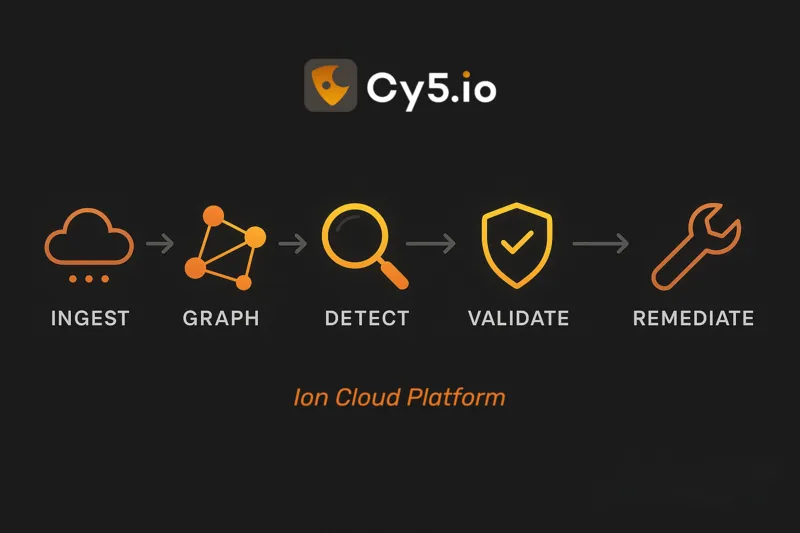
Attack path analysis (cloud): IAM / Network / Data / Kubernetes
Patterns you’ll see most:
- Identity-first (IAM): public workload → credential harvest → assume role → policy change → data access/exposure.
- Network-assisted: over-permissive SG/NSG → lateral move → management plane abuse via broad role.
- Data-centric: misconfigured share/bucket → key/secret exfil → persistence via CI/CD token.
- Kubernetes: Pod ServiceAccount → list/read Secrets → cloud role pivot (K8s→cloud).
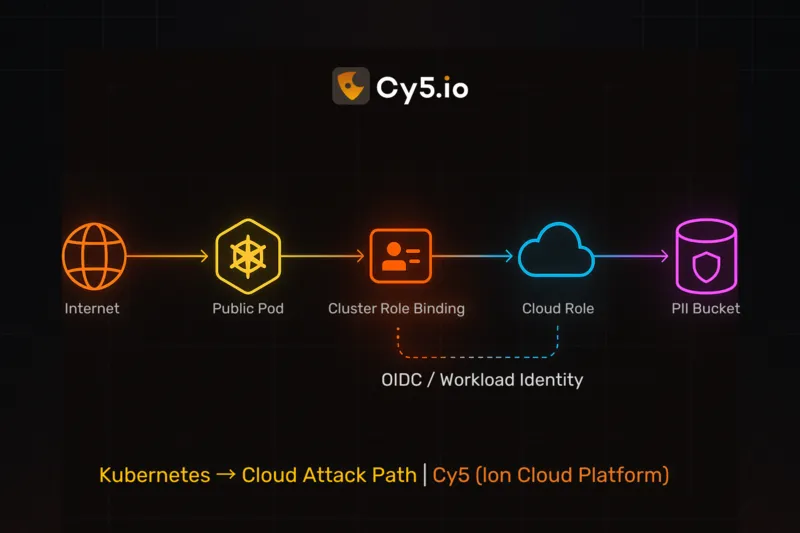
Cy5 cue: Every path in Cy5 includes the single smallest change that breaks the most routes (e.g., tighten one trust policy, remove a high-risk action, or close a peering path).
Kubernetes Pivots – Patterns, Controls, and Quick Queries
Why it matters. Many real incidents jump from Pod to Cloud via tokens and secrets. K8s needs to be in the same graph as IAM.
| Pattern | Graph shape | Path-breaking fix | Cy5 help |
|---|---|---|---|
| Pod SA can read Secrets | Pod → SA → Secret | Scope Secret to namespace; use CSI driver; limit SA | K8s Graph highlights SA→Secret edges; proposes RBAC diff |
| SA mapped to cloud Admin | SA → IRSA/Workload ID → Cloud Role(Admin) | Map to least-privilege role; add conditions | Shows which cloud actions the SA unlocks |
| Wildcard RBAC | SA → ClusterRoleBinding(:) | Replace with verb/resource scoped roles | RBAC Explorer simulates effective perms |
| Node compromise | DaemonSet → host mounts | Enforce PSP/Gatekeeper; block hostPath | Policy pack flags unsafe workloads |
Quick Checks
List wildcard roles/bindings.
kubectl get clusterrole -o json | jq '.items[] | select(.rules[]?.resources[]? == "*") | .metadata.name'
kubectl get clusterrolebinding -o json | jq '.items[] | select(.subjects[]? | .kind=="ServiceAccount") | .metadata.name'Detect Pods with SA tokens mounted.
kubectl get pods -A -o json | jq '.items[] | select(.spec.automountServiceAccountToken!=false) | .metadata|{ns:namespace,pod:name}'“Kubernetes isn’t just ‘runtime’—it’s an identity amplifier. If a Pod’s SA can reach a cloud role with policy-editing actions, your blast radius expands to your entire account/project. Break the SA→CloudRole link or scope it to a narrow, auditable purpose.” – Cy5 (Ion Cloud Platform) | Cloud Security Team
Risk scoring & contextual cloud security for Prioritization – transparent math + example
Goal. Make ranking explainable so security, platform, and auditors agree on why item X is top-priority.
Scoring model
risk_score(path) = Wexp*Exploitability + Wpriv*PrivilegeDepth + Wdata*DataSensitivity + Wtime*ExposureWindow
0–100 scale per factor; default weights: Wexp=0.35, Wpriv=0.25, Wdata=0.25, Wtime=0.15Factor Guides
- Exploitability (0–100): internet exposure (+30), known CVE on entry (+20), default creds/weak control (+20), public endpoint reachable without WAF (+30).
- PrivilegeDepth (0–100): number of hops (0–40), power of terminal action (e.g., policy write, KMS decrypt) (0–40), cross-account/project jump (0–20).
- DataSensitivity (0–100): none (0), internal (30), confidential (60), regulated/PII/keys/secrets (100).
- ExposureWindow (0–100): <1d (10), ≤7d (30), ≤30d (60), >30d (100).
Example: S3 Policy-Edit Path
- Exploitability: 85 (public SG + known CVE + no WAF)
- PrivilegeDepth: 70 (2 hops, policy write, cross-account)
- DataSensitivity: 100 (PII lake)
- ExposureWindow: 60 (23 days)
Compute:-
risk = 0.35*85 + 0.25*70 + 0.25*100 + 0.15*60
= 29.75 + 17.5 + 25 + 9
= 81.25Interpretation. ≥80 = urgent: must break within current sprint.
Cy5 bonus. Shows the delta after proposed fix; e.g., removing s3:PutBucketPolicy drops PrivilegeDepth to 40 → new score ≈ 70 (and path count falls from 12 to 3).
Blast Radius Math
blast_radius(entity) = count(unique crown_jewel assets reachable via any path containing entity)Before: AnalyticsRole reaches 17 sensitive assets (S3, Glue, Redshift).
After trust tightening: 5 assets.
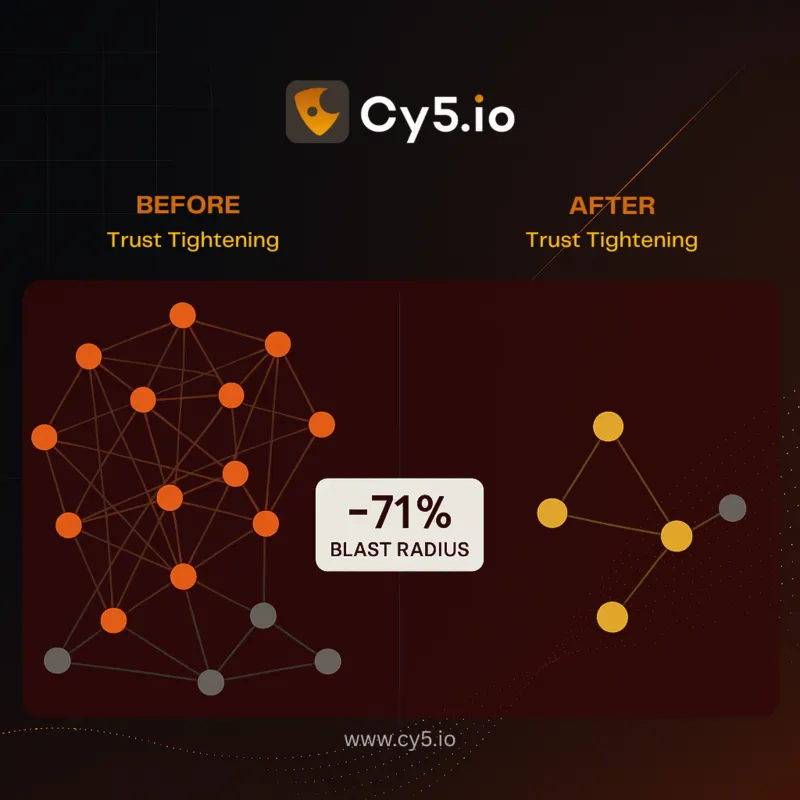
Cy5 UI: “This PR reduces blast radius by ~71%.”
Cy5 application: The Attack Path Board ranks fixes by total blast radius reduced per change, then auto-creates a remediation PR and Jira ticket with evidence links.
Provider Mini-Runbooks — AWS, Azure, GCP + Terraform Diffs
Goal: transform CSPM findings into entity-centric investigations and risk-based remediation.
AWS: Break an S3 exfiltration path via cross-account AssumeRole
Scenario. Internet-exposed EC2 in Acct-A can assume AnalyticsRole in Acct-B and run s3:PutBucketPolicy on a PII bucket.
What the graph shows (Cy5 Attack Path Board).
- Entry:
EC2PublicSG➜ instance metadata ➜AppProdRole - Hop:
sts:AssumeRole➜AnalyticsRole(Acct-B) - Action:
s3:PutBucketPolicyonbkt-pii-prod - Crown-jewel:
bkt-pii-prod(tag:data_sensitivity=PII)
Fix strategy (smallest change that breaks the most paths).
- Constrain trust on
AnalyticsRoleso only the CI/CD role in Acct-A can assume it. - Remove policy-altering power (
s3:PutBucketPolicy) fromAnalyticsRole.
Before (trust policy excerpt).
{
"Version": "2012-10-17",
"Statement": [{
"Effect": "Allow",
"Principal": {"AWS": "arn:aws:iam::<AcctA>:root"},
"Action": "sts:AssumeRole"
}]
}After (least-privilege trust).
{
"Version": "2012-10-17",
"Statement": [{
"Effect": "Allow",
"Principal": {"AWS": "arn:aws:iam::<AcctA>:role/ci-cd-runner"},
"Action": "sts:AssumeRole",
"Condition": {"StringEquals": {"aws:PrincipalTag/purpose": "release"}}
}]
}Terraform diff (Cy5-generated PR).
resource "aws_iam_role_policy" "analytics_inline" {
role = aws_iam_role.analytics_role.name
- policy = data.aws_iam_policy_document.analytics_policy.json
+ policy = data.aws_iam_policy_document.analytics_policy_hardened.json
}
data "aws_iam_policy_document" "analytics_policy_hardened" {
statement {
actions = [
- "s3:*"
+ "s3:GetObject",
+ "s3:ListBucket"
]
resources = [
aws_s3_bucket.pii.arn,
"${aws_s3_bucket.pii.arn}/*"
]
}
}Validation.
- Re-run path calc in Cy5 →
AnalyticsRoleno longer grants policy mutation; path score drops; blast radius across S3/Glue/Redshift goes down.
Azure: Collapse a Key Vault path by replacing over-broad Contributor
Scenario. Public VM ➜ lateral move ➜ principal with Contributor at subscription scope ➜ access to Key Vault policies.
Fix strategy.
- Replace
Contributorwith a custom role scoped to the resource group. - Enforce PIM/JIT for any elevation, and add Private Endpoints for Key Vault.
Custom role (minimal KV mgmt, no policy edits).
{
"Name": "KV-Operator-Min",
"IsCustom": true,
"Description": "Operate Key Vault without policy changes",
"Actions": [
"Microsoft.KeyVault/vaults/read",
"Microsoft.KeyVault/vaults/secrets/*/readMetadata"
],
"NotActions": [
"Microsoft.KeyVault/vaults/accessPolicies/write",
"Microsoft.Authorization/roleAssignments/write"
],
"AssignableScopes": [
"/subscriptions/<sub>/resourceGroups/rg-prod-sec"
]
}CLI steps.
az role definition create --role-definition kv-operator-min.json
az role assignment delete --assignee <principalId> --role "Contributor" --scope /subscriptions/<sub>
az role assignment create --assignee <principalId> --role "KV-Operator-Min" --scope /subscriptions/<sub>/resourceGroups/rg-prod-secCy5 assist. RBAC Explorer fingerprints the exact permissions keeping the path open, simulates the new role, and shows “path will break” before you commit.
GCP: Kill BigQuery exfil by replacing Basic Role + harden SA keys
Scenario. External identity ➜ Shared VPC host project ➜ roles/editor on data project ➜ BQ dataset export.
Fix strategy.
- Replace
roles/editorwith scopedroles/bigquery.dataVieweron only the needed dataset. - Rotate or remove service account keys; enforce VPC-SC for exfil barriers.
gcloud quick wins.
# Remove Editor
gcloud projects remove-iam-policy-binding $PROJECT \
--member="group:[email protected]" \
--role="roles/editor"
# Grant least-privilege on dataset only
bq add-iam-policy-binding project:dataset \
--member="group:[email protected]" \
--role="roles/bigquery.dataViewer"Cy5 assist. Policy Lens shows which bindings and SA keys keep the path viable, recommends replacements, and previews the attack exposure drop.
Kubernetes (all clouds): Audit ClusterRoleBinding/RoleBinding; limit Secret access; confirm Pods lack superfluous SA tokens. Cy5 K8s Graph visualizes Pod→SA→Secret→Cloud pivots and offers RBAC diffs.
Compliance & GEO Mapping
Use your graph as audit evidence: each control maps to a broken attack path, a least-privilege change, and an evidence trail (who/what/when).
1) NIST SP 800-53 Rev.5 — Practical Mapping
| Control | What auditors look for | Graph-driven evidence (what to export) | Example “path-breaking” fix |
|---|---|---|---|
| AC-2 / AC-3 / AC-6 (Accounts/Access/Least Priv) | Provisioning, authorization, least privilege | Identity node → effective permissions before/after; role bindings & conditions; change ticket | Replace Contributor/Editor with scoped custom role; add JIT/PIM |
| AC-17 / AC-20 (Remote/External) | Controlled external connections | Path start = internet/external principal; SG/NSG rules; WAF; private endpoints | Move KV/S3/Blob behind private endpoints; block 0.0.0.0/0 |
| AU-2 / AU-12 (Logging/Audit) | Coverage & integrity of logs | Which graph edges came from which logs/APIs; retention policy; immutable store | Route security logs to central lake; S3 Object Lock/immutability |
| CM-6 / CM-7 (Config/Least Functionality) | Hardened configs, no wildcards | Policy diff (before/after); wildcard detection report; IaC PR refs | Remove s3:*; scope to ARN; deny by default |
| RA-3 / RA-5 (Risk/Scanning) | Risk-based prioritization | Risk score formula + inputs; top paths ranked; MTTR per class | Prioritize externals → crown-jewel paths first |
| SC-7 (Boundary Protection) | Segmentation / egress controls | Network hops; peering/route tables; VPC-SC (GCP) | Kill peering; VPC-SC service perimeter |
| IR-4 (Response) | Verification of fix | Pre/post path recompute; artifact IDs; rollout time | Prove path score drop after PR merge |
Cy5 assist: one-click Evidence Pack (NIST) bundles the above with timestamps, reviewers, and PR IDs.
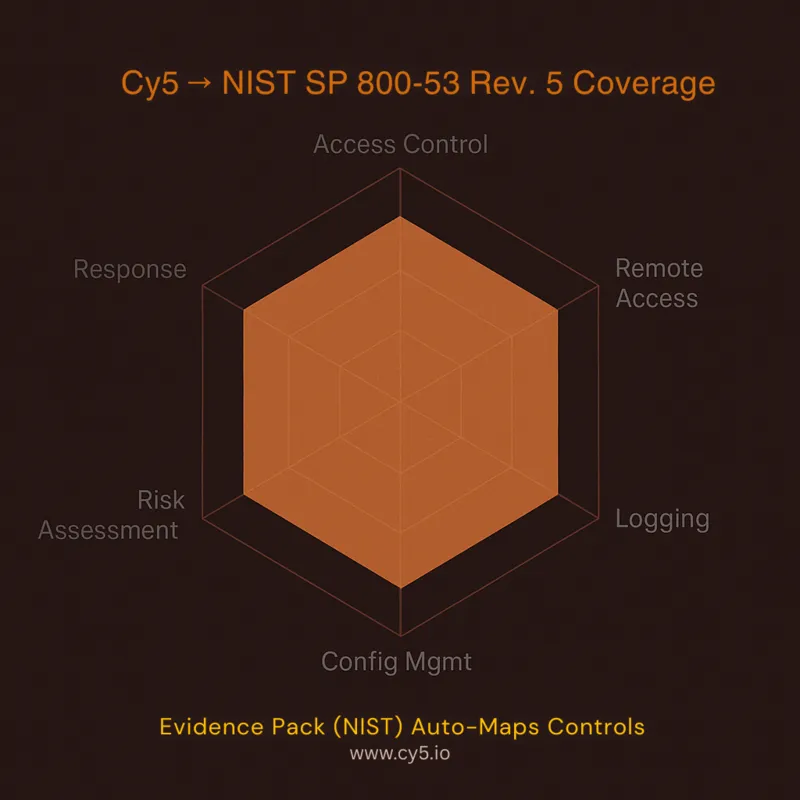
2) ISO/IEC 27001:2022 — Annex A
| ISO 27001:2022 Annex A | Intent | Graph-based proof | Typical fix |
|---|---|---|---|
| A.5.15 Access control | Limit access to need-to-know | Effective-permission snapshot & diff | Replace basic roles; restrict trust relationships |
| A.5.18 Access rights | Joiner/mover/leaver discipline | Identity lifecycle graph + last use | Revoke unused roles; expire SA keys |
| A.8.16 Monitoring activities | Detect misuse, anomalies | Attack path detections, lateral movement edges | Alert on “externally-initiated path to data” |
| A.8.28 Secure coding (for IaC) | Controlled change to infra | PR diff, approvers, checks passed | Policy tighten via Terraform/Bicep with checks |
| A.8.9 Configuration management | Baselines & drift | Config drift timeline → path creation date | Guardrail policy to block drift re-introductions |
Cy5 assist: Policy Lens shows which IaC change introduced a path; Drift Timeline timestamps exposure.
GDPR (EU/DACH) — Security of Processing (Art. 32) + Data Minimization (Art. 5(1)(c)) + Privacy by Design (Art. 25)
- What to prove: security appropriate to risk; data access minimized; changes tested before exposure.
- Graph evidence: crown-jewel labels (PII), who/what could reach them pre-fix, and the single change that removed reachability; show data-residency and role separation (no “data-admin = network-admin”).
- Operational move: keep attack-path simulations in-region where possible; redact PII in evidence exports.
Cy5 assist: Data Residency Mode + Redacted Evidence Pack (PII fields masked).
CERT-In (India) — Incident Reporting & Log Retention
- Practicals: keep cloud security logs for at least 180 days in India and be able to report qualifying incidents quickly (directive as of 2022).
- Graph evidence: show the path that led to the incident, affected identities/resources, and log pointers covering the full window.
- Ops tip: pre-stage an Incident Bundle template: path graph, timeline, log references, and containment PRs.
Cy5 assist: one-click Incident Bundle (CERT-In) with retention attestations.
MAS TRM (Singapore) — Access Governance, Monitoring, Incident Readiness
- Show: role design (least privilege), monitoring of sensitive access, and tested incident flows.
- Graph proof: access design per app/data domain; monitoring rules tied to path patterns (e.g., “external → key vault”).
- Ops tip: align SOAR playbooks to common path shapes (IAM-first, K8s-pivot, network-assist).
Cy5 assist: Path Pattern Library with mapped SOAR runbooks.
UAE NESA / TDRA IA — Segmentation, Logging, Privileged Access
- Show: segmented networks, logged admin actions, and constrained privileged roles.
- Graph proof: VNet/VPC segmentation in the path; admin actions removed; private links enforced.
Cy5 assist: Segmentation Map overlay inside the graph + audit export.
Tooling: Agentless vs Agent-Based vs Graph-Native
| Approach | Strengths | Gaps for threat hunting | Best use |
|---|---|---|---|
| Agentless CSPM | Fast coverage; config drift; framework checks (CIS/NIST/ISO) | Finds issues but misses chained paths | Baseline posture & compliance. (AWS Documentation) |
| Agent‑based | Runtime & EDR telemetry | Limited cloud IAM context | Workload telemetry & runtime threats. |
| Graph‑native (our focus) | Entity‑centric, shows attack paths, blast radius, risk‑based prioritization | Needs high‑quality graph + IAM resolution | Threat hunting & fix‑what‑matters. (AWS Documentation) |
Metrics & Analytics Playbook
Make improvement measurable and explainable. Tie every KPI to a path, a fix, and a business outcome.
Tier 1 — Executive KPIs (Board-Facing)
| KPI | Formula | Target (first 90 days) | Why it matters |
|---|---|---|---|
| Critical Attack Paths Open | count(paths where risk ≥ 80) | ↓ 60–80% | Directly tracks breach routes |
| Blast Radius (Crown-Jewel) | sum(unique assets reachable) per CJ | ↓ 50–70% | “What can burn if X is hit?” |
| MTTR-Path | mean(time fix-merged − time path-created) | ≤ 10 business days | Fast risk burn-down |
| Least-Privilege Delta | (pre − post) privileged actions / pre | ≥ 40% reduction | Quantifies entitlement diet |
| Compliance Drift Days | Σ days out-of-policy (top 10 controls) | ≤ 7 days each | Audit readiness |
Cy5 dashboards: Executive Overview tiles for each KPI with deltas and spark-lines.
Tier 2 — Operational KPIs (Team-Level)
| KPI | Definition | Collection |
|---|---|---|
| Path Density | paths per 100 cloud assets | Graph index nightly |
| Fix Leverage | paths closed per merged PR | Join graph events ↔ SCM |
| Regression Rate | % paths that reappear within 30 days | Compare daily snapshots |
| RBAC Wildcard Count | K8s ClusterRoles with * | K8s audit job |
| Basic Roles Remaining (GCP) | # members with roles/editor/owner | IAM export job |
| Public Endpoints to CJ | internet-exposed nodes within 2 hops of CJ | Graph query |
Cy5 automations: scheduled Graph Jobs push these to a warehouse (BigQuery/Snowflake) and the built-in Ops Scorecard.
Targets & SLA ladders (make it “real”)
- SLA-Path-Critical: P0 (risk ≥ 90): fix ≤ 5 business days; P1 (80–89): ≤ 10 days; P2 (70–79): backlog.
- SLO-Blast Radius: each crown-jewel ≤ 5 reachable assets by end of Q2.
- SLO-Least Privilege: no wildcard (
*) permissions in production by end of next sprint.
Cy5: enforce via Guardrails (policy checks) and PR Required Checks (path-recompute:pass).
Example Queries (Warehouse-Ready)
Paths closed per PR (last 30 days).
SELECT pr_id, COUNT(DISTINCT path_id) AS paths_closed
FROM graph.events
WHERE event_type='path_closed' AND event_ts >= CURRENT_DATE - 30
GROUP BY pr_id
ORDER BY paths_closed DESC;Blast radius by crown-jewel (trend).
SELECT cj_id, DATE(snapshot_ts) d, COUNT(DISTINCT reachable_asset_id) blast_radius
FROM graph.snapshots_reachability
GROUP BY cj_id, d
ORDER BY cj_id, d;GCP basic roles still present.
SELECT member, role
FROM iam.gcp_bindings
WHERE role IN ('roles/owner','roles/editor','roles/viewer');K8s wildcard RBAC (ClusterRoles).
kubectl get clusterrole -o json | jq '.items[] | select(.rules[]? | .resources[]? == "*") | .metadata.name'Scorecards you can ship tomorrow
Security Leadership (monthly)
- Critical paths open/closed, MTTR-Path trend, top 3 fix-leverage PRs, worst 3 regressions, compliance drift timeline.
Team/Tribe (bi-weekly)
- Paths per domain/service, PRs merged, “why still open” blockers (owner, dependency, blast-radius impact), next sprint targets.
Audit/Compliance (quarterly)
- Evidence summary by framework (NIST/ISO/CIS), control coverage vs drift days, incidents & lessons learned, top preventive guardrails added.
Cy5: prebuilt Executive, Ops, and Audit scorecards + CSV/PDF exports.
Decision tree: Where to start
- Internet-exposed assets near crown-jewels? → Run attack path analysis first.
- Broad roles (Owner/Admin/Contributor)? → Refactor to least-privilege with JIT.
- Too many highs, small team? → Use Cy5’s risk ranking to fix max impact first.
- Regulated region? → Export Evidence Pack for auditors.
6-Step Evaluation Checklist (CSPM/CNAPP Graph Capabilities)
- Graph coverage: identities, policies, resources, network, K8s
- Effective permissions across accounts/subscriptions/projects
- Attack path engine: multi-hop, exploitability focus, data-aware
- Explainable scoring + blast radius math
- Safe remediation: Terraform/CFN/Bicep PRs; pre-merge re-checks
- Compliance evidence: CIS/NIST/ISO mappings; drift timelines
(Cy5 checks all six.)
30/60/90-day adoption plan
- 0–30 days (Baseline): connect clouds; label crown-jewels; run first attack path sweep; close top 10 path-breaking fixes; enable MFA/JIT. (Cy5 QuickStart gets you a graph Day 1.)
- 31–60 (Harden): refactor broad roles; enforce private endpoints/segmentation; onboard K8s; define risk thresholds and SLAs; enable IaC PR flow.
- 61–90 (Operationalize): weekly path reviews; report on blast radius; export compliance evidence; integrate with SOAR for auto-validation.
Mini case vignette
A fintech across 3 clouds had 1,800 “highs” and no prioritization. A graph-driven pass in Cy5 surfaced 12 critical attack paths into a PII lake. Three changes (tightening one cross-account trust, closing a peering route, moving a key vault private) cut blast radius by 84% and closed 9/12 paths in two sprints.
Objections FAQ
No. It’s control-plane/API-driven and out-of-band. Cy5 runs asynchronously and validates changes before merge.
Path engines that focus on externally initiated, exploitable routes reduce noise. Cy5 also shows why a path is viable and what breaks it.
Prefer in-environment analysis where possible and minimal metadata exfil. Cy5 supports data-residency choices and evidence redaction.
You should—but CIS findings don’t show chains. Cy5 maps each finding to paths and ranks fixes by blast radius reduction.
Graphs enforce least-privilege and segmentation—Zero Trust fundamentals. Cy5 operationalizes them with continuous validation.





